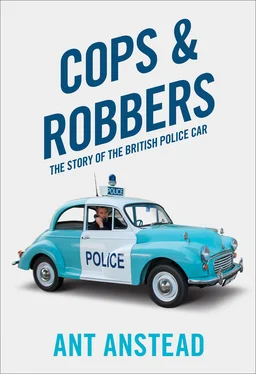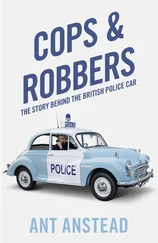As a result, the UK police started to take cars seriously, and the weight of public pressure – and in some cases outrage – meant that they had to. As far as research can prove, it was the Met that led the way, acquiring a Léon Bollée Voiturette in 1896, or possibly early 1897. The arrival of the Bollée, as it was usually called, is important because it represented the moment when the British police moved from enforcing legislation on motorists to becoming motorists themselves. Quite what those early Met police pioneer drivers would think of today’s high-speed chases on the M25 we shall never know, but to modern eyes the pioneering car does seem almost laughably poor in both performance and engineering terms. At that time the template for what makes an acceptable usable car, as opposed to an experiment down a dead-end avenue of design, was yet to be set, and the Mercedes-badged Daimler that made every other autocar old-fashioned overnight, and so set the car on its course to dominate transportation in developed nations by the early 1920s, would not appear until 1901.
1896 Léon Bollée Voiturette

The birth of the Léon-Bollée Voiturette light autocar goes back to the 1870s, when Amédée Bollée, son of a foundry owner specialising in bells, started making steam vehicles in Le Mans, France, way before the town became part of motor-racing folklore after Renault’s victory in the 1906 French Grand Prix there.
Although Amédée Bollée was a steam enthusiast, he could see the potential in gasoline-engined cars and helped both his sons, Amédée Junior and Léon, design and build them. Léon’s design was immediately successful, although I suspect anyone who ever crashed into anything while sitting on that front-mounted chair may have disagreed! The vehicle was considered fast in its day; even in their early days the police bought the fastest car they could afford, kicking off the arms race between the good and the bad guys earlier than most of us had realised!
Bollée’s design for a very short-wheelbased, 3-seater motor-tricycle, the Voiturette, weighed only 264lbs, used a tubular frame and featured a single back wheel, making it far more stable than having the single wheel at the front. The engine was an air-cooled, horizontal, single-cylinder unit of 650cc that was hung beside the back wheel on the near-side and used a large, heavy flywheel. It featured suction-opened inlet valves and mechanical exhaust valves with plain bronze bearings, hand-lubricated by grease for the main bearings and a splash-lubricated big-end. A tubular con-rod kept the weight down, while hot-tube ignition and a single-jet carburettor were so close to the float chamber that fires were common. The 3-speed transmission was by three virtually unlubricated gears on the end of the crank, which could be meshed with the three layshaft gears. The drive was by flat belt, a mechanism that was commonly used then to drive lathes and other machines in workshops. There was no actual clutch; the mechanical movement of the back wheel tightened or loosened the driving belt so that drive was achieved or neutral was obtained. Full-forward movement of the back wheel applied the belt rim to a stationary brake block. In some ways it was an elegantly simple solution; one fore and aft movement of the rear wheel achieved one of three outcomes. However, the Bollée was apparently quite tricky to actually drive, partly because it featured a small steering wheel on the driver’s right with a handle familiar to traction-engine drivers, which actuated an early rack-and-pinion steering system. Meanwhile, the left hand had to ease the gear stick gingerly back and forth to engage the drive or free it. Turning the spade grip at the top of this lever engaged a gear, and, in order to stop, the lever had to be hastily pulled backwards. I can’t imagine many of my former police colleagues (or myself, for that matter) taking it easily, but perhaps sheer fear would have engendered that on this device …
The Voiturette was powerful for its size and weight, and its low build made it stable, but the short wheelbase made spinning on slippery cobbled roads quite common, and comfort was not a priority because they had no suspension, relying on pneumatic tyres and a C-sprung seat to provide a modicum of relief. However, driven by what we must assume were men made of granite, they dominated their class in early motor races, famously occupying the top four places in the 1896 Paris-Mantes-Paris race, and winning their class in the 1897 Paris-Dieppe race with a time that was 0.6mph faster than the best four-wheeled car. Legendary English racing driver and Le Mans winner S.C.H. Sammy Davis bought an example in 1929 to use in the London to Brighton Veteran Car Run (a Léon Bollée Voiturette was apparently the first car across the line on the original Emancipation Run in 1896) and was pleased to achieve a maximum speed of 19mph when testing it at Brooklands! This would have been impressive in 1896; the first Land Speed Record was recorded in 1898 at 39mph. Amazing to think now how far we have come.
After being developed in the family’s Le Mans workshop, the car was produced in Paris, at 163 Avenue Victor Hugo, and at Le Harve by Diligent et Cie. It’s believed that around 750 units were made; Michelin ordered 200 and the Hon Charles Rolls (we all know who he was) was a customer in 1897. By 1899 new four-wheeled Bollées were being produced, some with much larger 4.6-litre engines, but the marque was bought by UK maker Morris in 1924, who produced the Morris-Léon Bollée until 1931. It finally faded away for good in 1933.
Léon Bollée’s tricycle may have been short-lived, but the word he appears to have invented to name it, Voiturette, lived on and became the generally accepted term for a small lightweight car. It comes from the French word for automobile, voiture , and became so ubiquitous that it was used to name a specific Voiturette racing class for lightweight cars with engines of 1.5 litres or smaller. The supercharged Alfa Romeo 158/159 Alfetta that so dominated F1 on its inception was, in fact, originally designed as a Voiturette class racer.

CHAPTER THREE
ADAPT AND ARREST
Or, ignore and watch them flee …

The police force had started policing roads prior to the advancement of the car, and complaints had been made about congestion in cities, especially London, in the first half of the nineteenth century, almost 100 years before cars caught on. Horses had a will of their own and were not always as well trained as they should have been … Indeed, the Great Exhibition of 1851 had taken traffic congestion at Hyde Park Corner as a theme, with various solutions being hypothesised. The passing of the Metropolitan Public Carriage Act 1869 vested many responsibilities into the hands of the police with regard to both Hackney and Public Carriages. By 1895, horseless carriages were appearing and major cities were getting motorised omnibuses or trams.
However, it’s easy to forget that in the 1890s it was by no means clear what cars were going to be. They were obviously going to be something, and that something was going to be important , but what that was, no one was quite sure. Some saw them as a miracle cure for congestion (they took up less space than a horse-drawn wagon) and some saw them as evil machines likely to kill everyone who came into contact with them. Most people, of course, held opinions that were between these two extremes. Petrol eventually came to the fore as the way forward for powering cars, but prior to that, steam, electric (which it now seems was 120 years or so ahead of its time, because battery technology and electronic control have only recently made this viable and it is now very obviously the future) and even coal dust and various other strange ideas were explored.
Читать дальше











